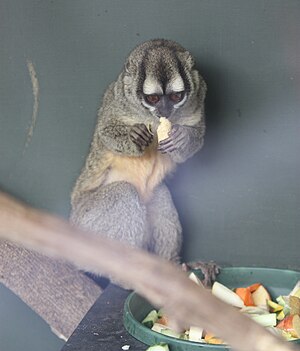Gray-hand night monkey
| Gray-hand night monkey | ||||||||||||
|---|---|---|---|---|---|---|---|---|---|---|---|---|

Gray-handed night monkey ( Aotus griseimembra ) |
||||||||||||
| Systematics | ||||||||||||
|
||||||||||||
| Scientific name | ||||||||||||
| Aotus griseimembra | ||||||||||||
| Elliot , 1912 |
The gray-hand night monkey ( Aotus griseimembra ) is a species of primate from the group of night monkeys (Aotidae). It is often considered a subspecies of the Colombian night monkey .
Like all night monkeys, gray-handed night monkeys are relatively small primates with large eyes that are adapted to their nocturnal lifestyle. The fur is gray-brown on the upper side, the belly is yellowish-orange. The arms and legs are gray and the hands and feet are brown in color. The tail is bushy and almost as long as the trunk. The head is rounded, the large eyes are brown, they are surrounded by white fields. Three dark stripes run along the head, one outside of each eye and one across the forehead to the nose. They differ from other night monkeys in the color of their limbs and in the number of chromosomes .
Gray-handed night monkeys inhabit northern Colombia and the far west of Venezuela . Their habitat are deeper forests.
Little is known about their way of life; it probably corresponds to that of the other night monkeys. Accordingly, they are nocturnal and usually stay in the trees. There they move on all fours and jump away. To sleep, they retire in tree hollows or thickets of plants. They live in monogamous family groups and live in fixed territories that they defend against other conspecifics.
The main diet of these animals consists of fruits, besides they also eat leaves and insects. Due to their nocturnal lifestyle, they avoid competition with diurnal, more dominant species.
Gray-handed night monkeys are threatened by the ongoing destruction of their habitat. In addition, there was heavy hunting, especially in the 1960s and 1970s, as these animals were used in animal experiments , which severely depleted the population. The IUCN lists the species as "endangered" ( vulnerable ).
In Germany the species is only kept in the Grzimek House in Frankfurt.
literature
- Thomas R. Defler, Marta L. Bueno: Aotus Diversity and the Species Problem. In: Primate Conservation. 22, 2007, ISSN 0898-6207 , pp. 55-70, PDF ( Memento from February 11, 2012 in the Internet Archive ).
- Thomas Geissmann : Comparative Primatology. Springer-Verlag, Berlin et al. 2003, ISBN 3-540-43645-6 .
- Ronald M. Nowak: Walker's Mammals of the World. 6th edition. Johns Hopkins University Press, Baltimore MD 1999, ISBN 0-8018-5789-9 .